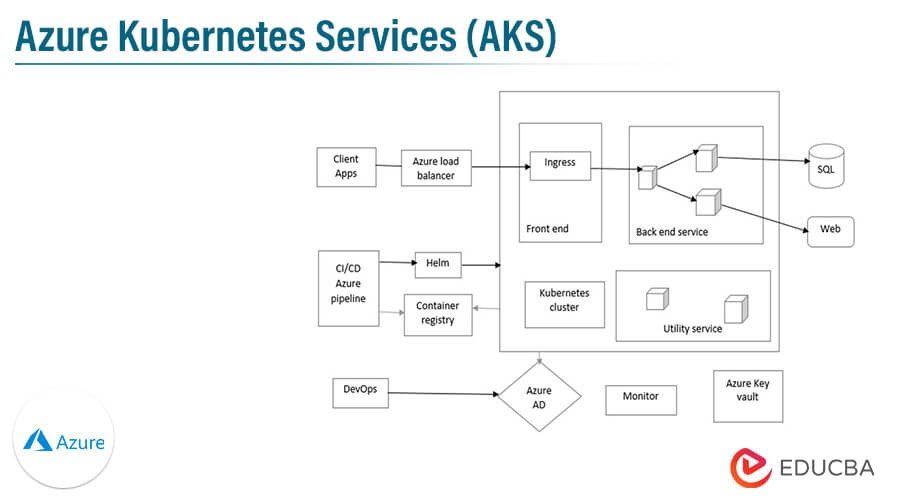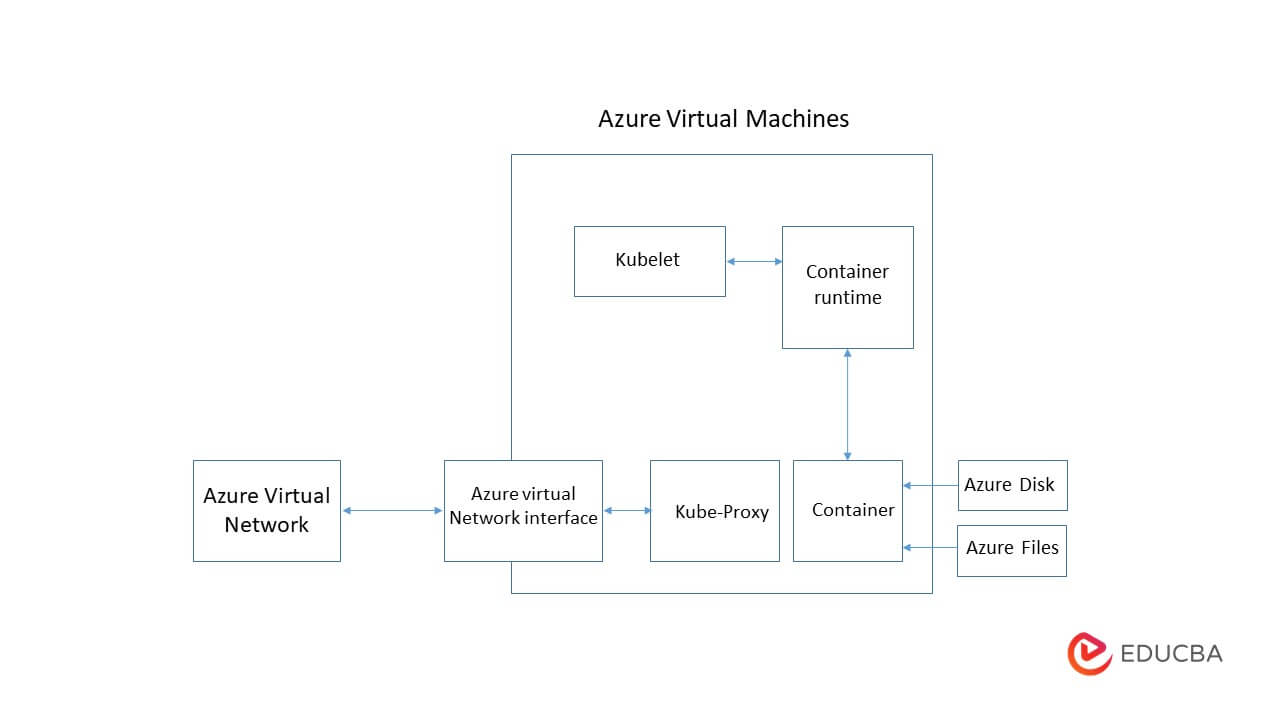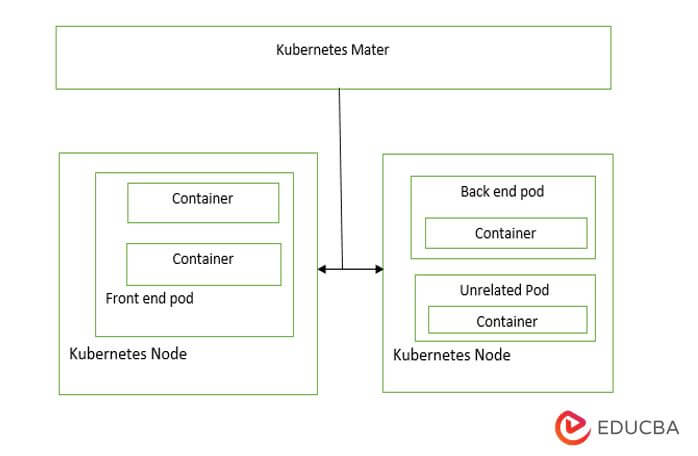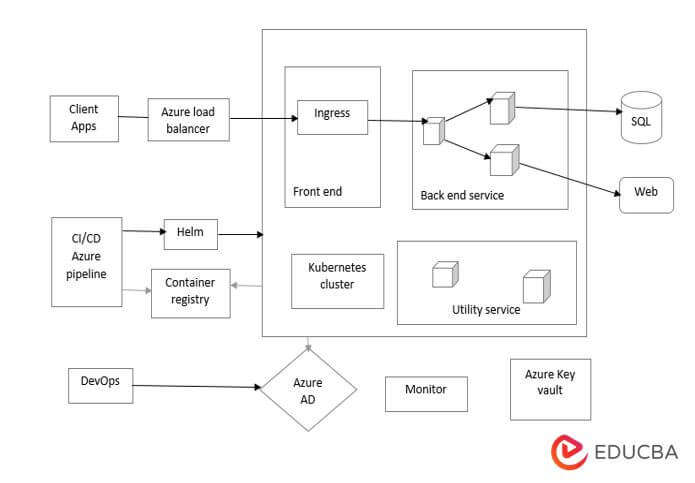Updated March 16, 2023
Introduction to Azure Kubernetes Services (AKS)
Azure kubernetes services (AKS) provide the quickest way to begin developing and deploying cloud-native apps into the azure data center or with cloud pipelines or guardrails. Azure kubernetes services provide governance and unified management for multi-cloud and edge kubernetes clusters. By offloading the operation overhead, the azure kubernetes service simplifies the deployment and management of kubernetes clusters in azure.
Key Takeaways
- Microsoft Azure offers the azure kubernetes service, which simplifies the deployment of kubernetes cluster in a public cloud environment. Also, it monitors the managed service of kubernetes.
- We can create the AKS cluster by using azure ALI or azure portal for managing the agent nodes.
What is Azure Kubernetes Services?
The azure kubernetes service is a managed container orchestration that is based on the kubernetes system and is available on Microsoft’s Azure public cloud. Our organization can use the Azure Kubernetes service to handle critical functions such as scaling, deploying, and managing container-based applications and Docker containers. AKS has been available since June 2018, and it is primarily used in software development.
The Azure Kubernetes service is an open-source platform used for container orchestration, but it requires a significant amount of overhead to manage the cluster. AKS helps with managing multiple overheads and reducing the complexity of management tasks. AKS is developed for building scalable applications by using docker.
How Azure AKS Works?
The azure AKS uses container-based application management and deployment, but it will contain the number of use cases in the service in a specified scope. The organization uses the AKS for automating and streamlining the application migration into the container. The AKS will first move the application into the specified container, and then it will register the container in order to launch the container into the preconfigured environment. AKS deploys the scale and also manages the diverse group of containers, which helped us in launching the microservices-based application.
At the time of running the azure kubernetes service, we need to manage the agent node and need pay only for the agent nodes. While we use the AKS service, there is no charge for the master node; it will be configured and deployed automatically.
Below figure shows how azure AKS will work as follows:
In the above example, we are using the main components in azure kubernetes service as follows:
- Azure virtual network
- Azure virtual network interface
- Kube-proxy
- Container
- Azure files
- Azure disk
- Kubelet
- Container runtime
The azure virtual machines will contain the container, kube proxy, and container runtime. Azure container is preferred to manage the cloud applications. Azure container instance provides a convenient way to manage the container in azure without managing the virtual machines.
Cluster
The control plane will be configured and created automatically when the kubernetes cluster is created. The control plane is a managed Azure resource that the user has direct access to.
- Management tools interaction.
- Maintaining the state and configuring the cluster of kubernetes.
- Specify and schedule which node is running the workload.
- Check the smaller actions like replication of kubernetes pods or node operations handling.
The user defines the number and size of nodes in the Azure platform configuration to secure the connection between the control plane and the node.
Below figure shows kubernetes cluster as follows:
AKS deployment covers two group names, the first group is for the resource of the kubernetes service, and the other is for the resource group node. The node resource group contains the resources of the infrastructure associated with the cluster. The service principle is used to create the other managed resources. AKS cluster will contain a single node. Memory and the central processing unit help the node to contain the part of the cluster.
Azure Kubernetes Services Architecture
Microsoft provides the reference architecture of azure kubernetes service. The architecture contains the following components:
- Azure kubernetes service
- Virtual network
- Kubernetes cluster
- Azure load balancer
- Ingress
- Azure active directory
- Azure container registry
- Azure Pipeline
- Helm
- Monitor
The below example shows the basic architecture of azure kubernetes service as follows. We are flowing the incoming traffic.
The azure kubernetes service is in the center of the architecture. The kubernetes cluster is used to run our workloads on AKS. The AKS creates the virtual network on which we deploy the agent nodes. We create the virtual network first at the time of defining the AKS architecture.
Ingress provides the HTTP or HTTPS path for accessing the AKS cluster services. We are creating the azure load balancer when our nginx ingress controller is created. The AKS microservices are stateless, and it stores data in external data stores. AKS will contain its AD, which is used to generate and control the resources of kubernetes deployments. Helm is nothing but the package manager of AKS. Azure monitor is used to collect and store the logs of the AKS service. Azure pipeline is a part of the devops service of azure.
Azure Kubernetes Services Security Management
Securing the azure kubernetes service is very important. We need to secure the kubernetes service from unauthenticated access. The security of the container protects the end-to-end pipeline to build the workloads of the application. The secure supply includes the registry and builds the environment. Kubernetes includes the components of security, such as secrets and pod security standards. Azure includes components like Microsoft defender for containers, active directories, key vault, azure policy, and many more. AKS is combining the security components into the following.
- Provide complete authorization and authentication.
- Leverages the AKS for the azure policy for securing our applications.
- End-to-end in-sight for the container of Microsoft defender.
- Keep the AKS cluster which was running from the latest security updates.
- Provide the secure pod traffic for accessing the sensitive credentials.
Azure kubernetes service is providing the below points related to security management as follows:
- Build security – In AKS, it is very important to conduct the static analysis of image build before promoting the same for the pipeline.
- Registry security – To access the state of vulnerability, it is part of managed service, and it is provided by Microsoft.
- Cluster security – Master component of kubernetes is part of a managed service, and it is maintained by Microsoft.
- Node security – AKS nodes are the azure virtual machine nodes that were managed and maintained by Microsoft.
Monitor
The azure monitoring collects the logs from the azure service that was used to interact with the kubernetes cluster, including nodes containers and AKS controllers. We use the same data to monitor applications, configure dashboards and alerts, and analyze root causes of errors. Admin is monitoring the container’s health by collecting processor and memory metrics from the container.
We are also monitoring the node of kubernetes and another part of the cluster. We are using container logs for collecting and storing more detailed analytics for troubleshooting. The monitoring of AKS data is available in the AKS portal of management. We can also check it from API and CLI.
Features
The deployment, which was a template, based is chosen for deploying the AKS cluster, which manages the master auto-configuration and worker nodes for the kubernetes cluster.
Below are the additional features of AKS as follows:
- Monitoring
- Azure active directory
- Advanced networking
- Security
Below are the features of AKS, below features are showing the azure kubernetes service.
- Enterprise commitment and open source environment – Kubernetes is business oriented. Microsoft inducted a number of employees in kubernetes for the easier business of developers.
- Nodes and cluster – AKS is supporting the services which were running onto the node of kubernetes. Those nodes are running on azure virtual machines.
- Role-based access control – AKS is integrating with the active directory of azure, so we are providing role-based access control.
- Integration of development tools – The important feature of AKS is development tools like draft and helm, which was providing a quick experience of development to dev teams.
- Running workload in AKS – We can orchestrate the workload of the AKS environment. We can also move the NET app to a windows server.
- Remove complexities – AKS is removing the installation, maintenance, implementation, and security complexities from the cloud of azure.
Conclusion
The azure kubernetes service is a managed container orchestration that is based on the kubernetes system, and the same is available on a public cloud of Microsoft Azure. Azure kubernetes services (AKS) offer the quickest way to develop and deploy the apps of cloud-native into the azure data center or with the cloud pipelines or guardrails.
Recommended Articles
This is a guide to Azure Kubernetes Services (AKS). Here we discuss the introduction, working, architecture, azure kubernetes services security management, and features. You can also look at the following articles to learn more –





